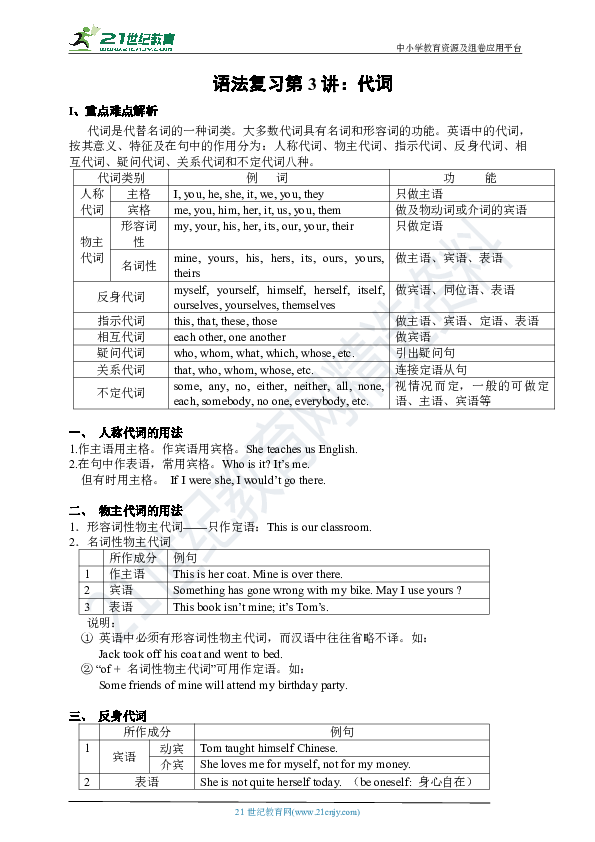
中小学教育资源及组卷应用平台 语法复习第3讲:代词 I、重点难点解析 代词是代替名词的一种词类。大多数代词具有名词和形容词的功能。英语中的代词,按其意义、特征及在句中的作用分为:人称代词、物主代词、指示代词、反身代词、相互代词、疑问代词、关系代词和不定代词八种。 代词类别 例 词 功 能 人称代词 主格 I, you, he, she, it, we, you, they 只做主语 宾格 me, you, him, her, it, us, you, them 做及物动词或介词的宾语 物主代词 形容词性 my, your, his, her, its, our, your, their 只做定语 名词性 mine, yours, his, hers, its, ours, yours, theirs 做主语、宾语、表语 反身代词 myself, yourself, himself, herself, itself, ourselves, yourselves, themselves 做宾语、同位语、表语 指示代词 this, that, these, those 做主语、宾语、定语、表语 相互代词 each other, one another 做宾语 疑问代词 who, whom, what, which, whose, etc. 引出疑问句 关系代词 that, who, whom, whose, etc. 连接定语从句 不定代词 some, any, no, either, neither, all, none, each, somebody, no one, everybody, etc. 视情况而定,一般的可做定语、主语、宾语等 一、 人称代词的用法 1.作主语用主格。作宾语用宾格。She teaches us English. 2.在句中作表语,常用宾格。Who is it? It’s me. 但有时用主格。 If I were she, I would’t go there. 二、 物主代词的用法 1.形容词性物主代词———只作定语:This is our classroom. 2.名词性物主代词 所作成分 例句 1 作主语 This is her coat. Mine is over there. 2 宾语 Something has gone wrong with my bike. May I use yours ? 3 表语 This book isn’t mine; it’s Tom’s. 说明: ① 英语中必须有形容词性物主代词,而汉语中往往省略不译。如: Jack took off his coat and went to bed. ② “of + 名词性物主代词”可用作定语。如: Some friends of mine will attend my birthday party. 三、 反身代词 所作成分 例句 1 宾语 动宾 Tom taught himself Chinese. 介宾 She loves me for myself, not for my money. 2 表语 She is not quite herself today. (be oneself: 身心自在) 3 同位语 I myself can repair the bike. 四、指示代词的用法 1.时空的差别 e.g. There is this seat here, near me, or there is that one in the fourth row. Which will you have, this or that? 2. This 和 that 在行文叙述上的差别。 e.g. I shall say this to you: he is a poor man. He was ill. That’s why he didn’t come. 3.that 和 those 用于表比较的结构。 The weather of Zhanjiang is better than that of my hometown. TV sets made in Nanjing are better than those made here. 4. 打电话时this 表示我,that表示你. 五、 不定代词的用法 可数 one, each, many, both, another, either, neither, (a) few 不可数 much, (a) little 可数不可数 none, any, other, all, some 复合不定代词 anyone, anybody, anything; someone, somebody, something; everyone, everybody, everything; nobody, nothing 1.none, no one, nothing 的用法区别 1)none 既可指人,也可指物,且一定是特指概念,常用来回答how many /much 引导的疑问句;no one 只能指人,且只能是泛指概念,常用来回答who 引导的疑问句;nothing “什么也没有”,否定一切,常用来回答what 引导的疑问句。如: — How many people are there in the room now ? — None. — Who is in the room ? — No one / nobody. 2) none 后面可加of 引导的介词短语,而something / anything / everything ... ...
~~ 您好,已阅读到文档的结尾了 ~~